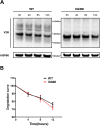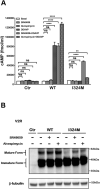Functional characterization of a loss-of-function mutant I324M of arginine vasopressin receptor 2 in X-linked nephrogenic diabetes insipidus
- PMID: 34040143
- PMCID: PMC8154955
- DOI: 10.1038/s41598-021-90736-z
Functional characterization of a loss-of-function mutant I324M of arginine vasopressin receptor 2 in X-linked nephrogenic diabetes insipidus
Abstract
X-linked nephrogenic diabetes insipidus (X-linked NDI) is a rare inherited disease mainly caused by lost-of-function mutations in human AVPR2 gene encoding arginine vasopressin receptor 2 (V2R). Our focus of the current study is on exploration of the functional and biochemical properties of Ile324Met (I324M) mutation identified in a pedigree showing as typical recessive X-linked NDI. We demonstrated that I324M mutation interfered with the conformation of complex glycosylation of V2R. Moreover, almost all of the I324M-V2R failed to express on the cell surface due to being captured by the endoplasmic reticulum control system. We further examined the signaling activity of DDAVP-medicated cAMP and ERK1/2 pathways and the results revealed that the mutant receptor lost the ability in response to DDAVP stimulation contributed to the failure of accumulation of cAMP and phosphorylated ERK1/2. Based on the characteristics of molecular defects of I324M mutant, we selected two reagents (SR49059 and alvespimycin) to determine whether the functions of I324M-V2R can be restored and we found that both compounds can significantly "rescue" I324M mutation. Our findings may provide further insights for understanding the pathogenic mechanism of AVPR2 gene mutations and may offer some implications on development of promising treatments for patients with X-linked NDI.
Conflict of interest statement
The authors declare no competing interests.
Figures






Similar articles
-
Identification, characterization and rescue of a novel vasopressin-2 receptor mutation causing nephrogenic diabetes insipidus.Clin Endocrinol (Oxf). 2009 Sep;71(3):388-93. doi: 10.1111/j.1365-2265.2008.03513.x. Epub 2008 Dec 18. Clin Endocrinol (Oxf). 2009. PMID: 19170711 Free PMC article.
-
A novel AVPR2 splice site mutation leads to partial X-linked nephrogenic diabetes insipidus in two brothers.Eur J Pediatr. 2016 May;175(5):727-33. doi: 10.1007/s00431-015-2684-4. Epub 2016 Jan 21. Eur J Pediatr. 2016. PMID: 26795631 Free PMC article.
-
Altered agonist sensitivity of a mutant v2 receptor suggests a novel therapeutic strategy for nephrogenic diabetes insipidus.Mol Endocrinol. 2014 May;28(5):634-43. doi: 10.1210/me.2013-1424. Epub 2014 Mar 14. Mol Endocrinol. 2014. PMID: 24628417 Free PMC article.
-
Identification and characterization of a novel X-linked AVPR2 mutation causing partial nephrogenic diabetes insipidus: a case report and review of the literature.Metabolism. 2012 Jul;61(7):922-30. doi: 10.1016/j.metabol.2012.01.005. Epub 2012 Mar 3. Metabolism. 2012. PMID: 22386940 Review.
-
Genetic forms of nephrogenic diabetes insipidus (NDI): Vasopressin receptor defect (X-linked) and aquaporin defect (autosomal recessive and dominant).Best Pract Res Clin Endocrinol Metab. 2016 Mar;30(2):263-76. doi: 10.1016/j.beem.2016.02.010. Epub 2016 Mar 2. Best Pract Res Clin Endocrinol Metab. 2016. PMID: 27156763 Review.
References
-
- Birnbaumer M, Gilbert S, Rosenthal W. An extracellular congenital nephrogenic diabetes insipidus mutation of the vasopressin receptor reduces cell surface expression, affinity for ligand, and coupling to the Gs/adenylyl cyclase system. Mol. Endocrinol. 1994;8:886–894. - PubMed
Publication types
MeSH terms
Substances
LinkOut - more resources
Full Text Sources
Other Literature Sources
Miscellaneous

